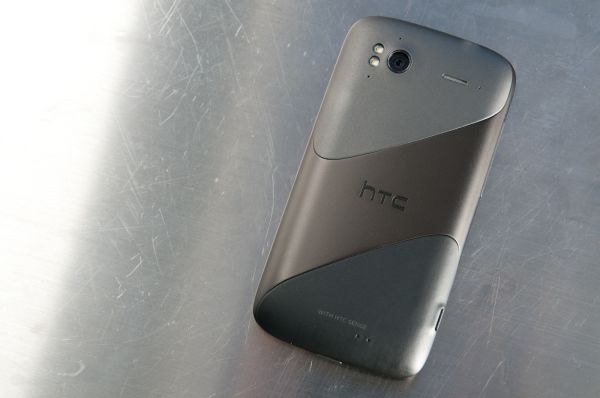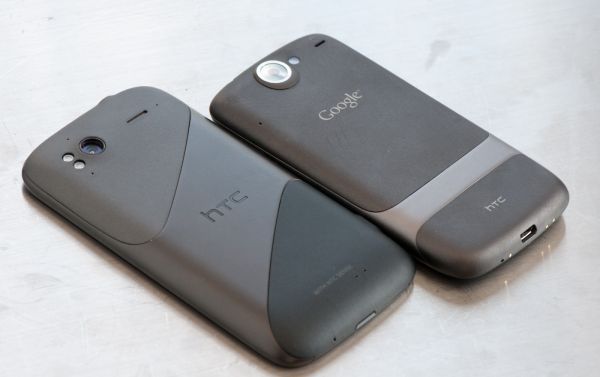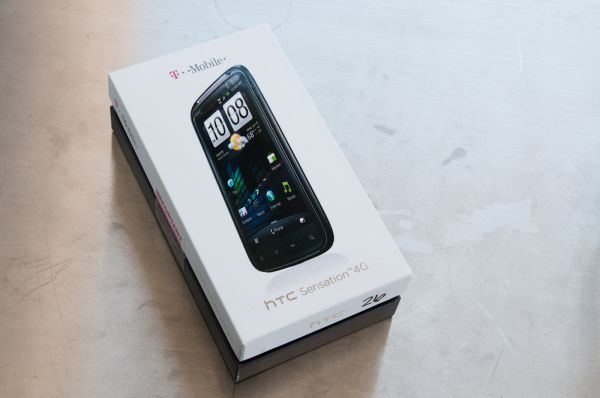HTC Sensation 4G Review - A Sensational Smartphone
by Brian Klug on July 1, 2011 12:38 AM EST- Posted in
- Smartphones
- HTC
- Android
- Mobile
- HTC Sensation
- MSM8260
I like what HTC has been up to lately. Rather than fighting a race to the bottom with endless soulless variants of the same piece of hardware in a crowded (and fiercely competitive) Android handset market, it’s trying to grow beyond just being a handset manufacturer.
I hate starting reviews with history lessons, but in this case we really do need to step back to see where HTC is coming from. In the beginning, HTC was a nameless OEM for other more famous brands. Its clients were smartphone and Pocket PC names like Palm with its Treo, Compaq with its iPaq, Dell with a number of the Axim PDAs, and UTStarcomm. As Windows Mobile aged and showed little signs of improving, HTC took its first step outside the bounds of being just a hardware assembler by taking on an ambitious project to revitalize Windows Mobile with a software skin. The fruits of this effort were TouchFlo, and later TouchFlo 3D UIs - which eventually would become HTC Sense. Somewhere between the release of the HTC Mogul and HTC Touch Pro, HTC realized that its future wasn’t purely in manufacturing devices for other handset vendors, but in leveraging its own brand. The combination of continually improving industrial design, software, and its own direction have turned HTC into the device manufacturer it is today.
Things have come a long, long way since the HTC Dream, and today we’re looking at HTC’s latest and greatest with the HTC Sensation.
I get a bit excited every time I look at the HTC Sensation. It’s a device with perhaps the strongest and most bold design language of any HTC phone to date. You can pretty much chart HTC’s design language by looking at each generation of its international handsets.
The HTC Desire was essentially an international version of the Nexus One, with hardware buttons but the same 65nm single core Snapdragon QSD8250 SoC. The second generation was the HTC Desire HD, which brought a larger 4.3” screen and 45nm Snapdragon MSM8255 SoC. The third step is the HTC Sensation, which ups resolution from WVGA 800x480 to qHD 960x540 and brings a 45nm dual core Snapdragon MSM8260 SoC.
| Physical Comparison | ||||||
| Apple iPhone 4 | HTC Thunderbolt | LG Optimus 2X/G2x | HTC Sensation | |||
| Height | 115.2 mm (4.5") | 122 mm (4.8") | 123.9 mm (4.87") | 126.3 mm (4.97") | ||
| Width | 58.6 mm (2.31") | 67 mm (2.63") | 63.2 mm (2.48") | 65.5 mm (2.58") | ||
| Depth | 9.3 mm ( 0.37") | 13.2 mm (0.52") | 10.9 mm (0.43") | 11.6 mm (0.46") | ||
| Weight | 137 g (4.8 oz) | 183.3 g (6.46 oz) | 139.0 g (4.90 oz) | 148 g (5.22 oz) | ||
| CPU | Apple A4 @ ~800MHz | 1 GHz MSM8655 45nm Snapdragon | 1 GHz Dual Core Cortex-A9 Tegra 2 AP20H | 1.2 GHz Dual Core Snapdragon MSM8260 | ||
| GPU | PowerVR SGX 535 | Adreno 205 | ULP GeForce | Adreno 220 | ||
| RAM | 512MB LPDDR1 (?) | 768 MB LPDDR2 | 512 MB LPDDR2 | 768 MB LPDDR2 | ||
| NAND | 16GB or 32GB integrated | 4 GB NAND with 32 GB microSD Class 4 preinstalled | 8 GB NAND with up to 32 GB microSD | 4 GB NAND with 8 GB microSD Class 4 preinstalled | ||
| Camera | 5MP with LED Flash + Front Facing Camera | 8 MP with autofocus and dual LED flash, 720p30 video recording, 1.3 MP front facing | 8 MP with AF/LED Flash, 1080p24 video recording, 1.3 MP front facing | 8 MP AF/Dual LED flash, VGA front facing | ||
| Screen | 3.5" 640 x 960 LED backlit LCD | 4.3” 800 x 480 LCD-TFT | 4.3" 800 x 480 LCD-TFT | 4.3" 960 x 540 S-LCD | ||
| Battery | Integrated 5.254Whr | Removable 5.18 Whr | Removable 5.6 Whr | Removable 5.62 Whr | ||
Physically it’s obvious that each successive device builds on the former. They’re all backed with HTC’s trademark purple-grey metal and have similar in-hand feel as a result. When I look at the Sensation, I see the Desire crossed with the Desire HD. When I actually hold the Sensation, I feel like I’m holding a grown-up Nexus One.
The two share that trademark combination of slightly rubbery plastic and metal, and as a result the device feels grippy, solid, and confident. What the Sensation also really continues from the other devices is the lack of a hard lip of any kind at the edge, instead every corner rolls off giving the phone a smooth feeling. The sensation of holding something rigid and expensive is communicated by that combination of materials, rather than the cheap plasticky feel conveyed by a number of other handsets.
The Sensation comes in the same style of packaging that we've seen other T-Mobile phones arrive in. It's a two-part box with a thin middle strip. The top lifts off revealing the phone, and underneath that is the usual paperwork, HTC AC adapter and microUSB cable, and earbuds.
I started off making one monolithic video for the Sensation, but that ended up being unwieldy, so I split it into multiple parts. The first one is simply a look at the hardware from all angles, torn down, and how it compares to both HTC's legacy devices and some of its modern contenders.



















107 Comments
View All Comments
mikehunt80 - Friday, July 1, 2011 - link
Yeah, nvidia need a slap for leaving h264 main/high out of their hardware codec in Tegra 2 and not bothering to add Neon.Cardinal sin!
metafor - Friday, July 1, 2011 - link
DICE player allowed you to play 1080p mkv on the Sensation. I've even played Blu-ray rips, though not at really high bitrates (20mbps I believe).ph00ny - Wednesday, July 6, 2011 - link
search button can be triggered by holding the menu button also having the physical home button also means no accidental tiggersnraudigy2 - Saturday, July 9, 2011 - link
S2 will play 1080 Adobe Flash video. Sensation will get up to 720, but G2X and Optimus only play 480p.ph00ny - Wednesday, July 6, 2011 - link
I've been recommending sensation over GSII just so that i will be the only one with GSII...But anyone that has tried both devices have said GSII is noticeably quicker that includes the Tmobile employee that was letting me test drive the device while she played with mine
Chloiber - Friday, July 1, 2011 - link
There are 2 negative points regarding the Sensation which keep me from buying the phone:1. As you mentioned, the space between the display and the case. Many users already got dirt and dust under their display.
2. Choppy performance. It's a dualcore phone and the browser is still very choppy - I can't live with that. I don't buy a DC phone just to see choppy browsing.
At the same time, other high end phones like the Galaxy S2 suffer from huge problems too. The praised display has huge drawbacks. A yellowish tint and gradient from left to right and huge banding issues. It's very well documented on XDA.
I expect those things on mediocre phones. But choppy browsing performance despite a DC SoC or problems with the display (be it dirt or just a crappy display) are a no go for a super high end smart phone for me. So I'll probably wait for the next Nexus.
piroroadkill - Friday, July 1, 2011 - link
Try Opera Mobile.Chloiber - Friday, July 1, 2011 - link
True, Opera mobile is really smooth, even on my Desire. I'm still somewhat disappointed in the browsing experience on stock Sense.Myrandex - Friday, July 1, 2011 - link
That's one of the things I love about Windows Phone 7. The smoothness of the platform, even on older hardware, is amazing. When comparing it with an Android phone back when I purchased (last November) my LG Quantum, and the Android device actually had better hardware, the choppiness was unreal. I would hope that it would be better with these DC phones but it doesn't seem to be the case.Jason
Will Robinson - Friday, July 1, 2011 - link
Nice review guys,wondering why the Samsung Galaxy S wasn't included in any of the benchmarking?